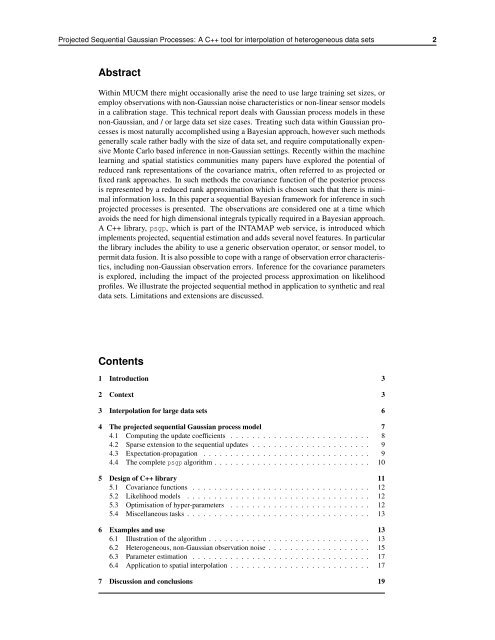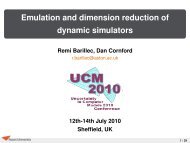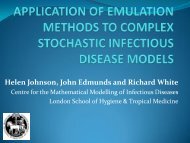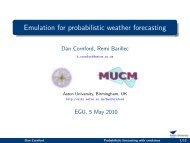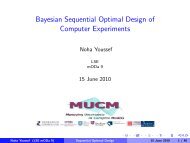Projected Sequential Gaussian Processes: A C++ tool for ... - MUCM
Projected Sequential Gaussian Processes: A C++ tool for ... - MUCM
Projected Sequential Gaussian Processes: A C++ tool for ... - MUCM
Create successful ePaper yourself
Turn your PDF publications into a flip-book with our unique Google optimized e-Paper software.
<strong>Projected</strong> <strong>Sequential</strong> <strong>Gaussian</strong> <strong>Processes</strong>: A <strong>C++</strong> <strong>tool</strong> <strong>for</strong> interpolation of heterogeneous data sets 2<br />
Abstract<br />
Within <strong>MUCM</strong> there might occasionally arise the need to use large training set sizes, or<br />
employ observations with non-<strong>Gaussian</strong> noise characteristics or non-linear sensor models<br />
in a calibration stage. This technical report deals with <strong>Gaussian</strong> process models in these<br />
non-<strong>Gaussian</strong>, and / or large data set size cases. Treating such data within <strong>Gaussian</strong> processes<br />
is most naturally accomplished using a Bayesian approach, however such methods<br />
generally scale rather badly with the size of data set, and require computationally expensive<br />
Monte Carlo based inference in non-<strong>Gaussian</strong> settings. Recently within the machine<br />
learning and spatial statistics communities many papers have explored the potential of<br />
reduced rank representations of the covariance matrix, often referred to as projected or<br />
fixed rank approaches. In such methods the covariance function of the posterior process<br />
is represented by a reduced rank approximation which is chosen such that there is minimal<br />
in<strong>for</strong>mation loss. In this paper a sequential Bayesian framework <strong>for</strong> inference in such<br />
projected processes is presented. The observations are considered one at a time which<br />
avoids the need <strong>for</strong> high dimensional integrals typically required in a Bayesian approach.<br />
A <strong>C++</strong> library, psgp, which is part of the INTAMAP web service, is introduced which<br />
implements projected, sequential estimation and adds several novel features. In particular<br />
the library includes the ability to use a generic observation operator, or sensor model, to<br />
permit data fusion. It is also possible to cope with a range of observation error characteristics,<br />
including non-<strong>Gaussian</strong> observation errors. Inference <strong>for</strong> the covariance parameters<br />
is explored, including the impact of the projected process approximation on likelihood<br />
profiles. We illustrate the projected sequential method in application to synthetic and real<br />
data sets. Limitations and extensions are discussed.<br />
Contents<br />
1 Introduction 3<br />
2 Context 3<br />
3 Interpolation <strong>for</strong> large data sets 6<br />
4 The projected sequential <strong>Gaussian</strong> process model 7<br />
4.1 Computing the update coefficients . . . . . . . . . . . . . . . . . . . . . . . . . . 8<br />
4.2 Sparse extension to the sequential updates . . . . . . . . . . . . . . . . . . . . . . 9<br />
4.3 Expectation-propagation . . . . . . . . . . . . . . . . . . . . . . . . . . . . . . . 9<br />
4.4 The complete psgp algorithm . . . . . . . . . . . . . . . . . . . . . . . . . . . . . 10<br />
5 Design of <strong>C++</strong> library 11<br />
5.1 Covariance functions . . . . . . . . . . . . . . . . . . . . . . . . . . . . . . . . . 12<br />
5.2 Likelihood models . . . . . . . . . . . . . . . . . . . . . . . . . . . . . . . . . . 12<br />
5.3 Optimisation of hyper-parameters . . . . . . . . . . . . . . . . . . . . . . . . . . 12<br />
5.4 Miscellaneous tasks . . . . . . . . . . . . . . . . . . . . . . . . . . . . . . . . . . 13<br />
6 Examples and use 13<br />
6.1 Illustration of the algorithm . . . . . . . . . . . . . . . . . . . . . . . . . . . . . . 13<br />
6.2 Heterogeneous, non-<strong>Gaussian</strong> observation noise . . . . . . . . . . . . . . . . . . . 15<br />
6.3 Parameter estimation . . . . . . . . . . . . . . . . . . . . . . . . . . . . . . . . . 17<br />
6.4 Application to spatial interpolation . . . . . . . . . . . . . . . . . . . . . . . . . . 17<br />
7 Discussion and conclusions 19


